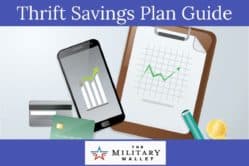Congress created the Thrift Savings Plan as part of the Federal Employees’ Retirement System Act of 1986. The TSP offers the same tax and retirement savings benefits that individuals receive from their 401(k) plans through private corporations. Members of the uniformed forces, including those in the ready reserve, became eligible to participate in the military TSP in 2001.
The TSP is a defined contribution plan. This means the retirement income you receive from your TSP account will depend on how much you contribute during your working years, as well as the earnings that accumulate over that time.
You can effectively use your TSP in any tax bracket, as long as you’re contributing the right amount for your unique financial situation.
By learning about your options and investing according to your personal financial situation, you’ll be able to make the most of your TSP account and help set yourself up for a comfortable retirement.
Why You Should Invest in the Thrift Savings Plan
You are responsible for your retirement. You may think your military retirement pay will be enough to live on, but fewer than 20% of service members serve long enough to draw military retirement pay or adequate pay through the Blended Retirement System.
What about Social Security benefits? Yes, Social Security benefits should help.
But think about these issues for a moment:
- The Social Security Administration has stated that it expects benefits are expected to be depleted by 2034. After that period, the program is expected to pay out at a reduced level of 75%.
- Chances are you will live longer than you think. According to a 2022 report from the American Academy of Actuaries, many retirees live for at least 20 years after they reach retirement age (65).
- Are you factoring in medical costs during your retirement? The average 65-year-old couple will spend approximately $315,000 on medical expenses during retirement, according to Fidelity Benefits Consulting’s retiree health care cost estimate.
Start Investing Now
You’ve probably heard that you should start investing early. This can seem counterintuitive because you may not make that much money between the ages of 18 and 25.
But, if you start investing early in your lifetime, the effects of compounding can be tremendous.
Let’s say you start setting aside about $19 a week ($1,000 annually) when you are 25 years old. You put it in a retirement account earning 8% a year, compounded monthly. If you stop investing completely when you turn 35, your total investment can still grow to about $165,000 by the time you turn 65 and are ready to retire.
Here’s where it gets interesting.
Let’s say you do the same thing, but instead of starting at 25, you don’t begin investing $19 weekly ($1,000 a year) until you turn 35. But, you continue investing that much every single year until you turn 65 (roughly 30 years).
Assuming an 8% return, compounded monthly, how much would you have when you’re 65?
Only about $123,000.
Even though you contributed three times as much money, you ended up with less because you started investing later in life, and couldn’t take advantage of compounding interest for as long as a 25-year-old.
Are You Making the Most of Your TSP Account?
Federal employees who participate in the TSP are automatically eligible for agency-matching contributions of up to 5% of their pay.
Military members who enlisted after Jan. 1, 2018, and those who opted into the Blended Retirement System (BRS) are also eligible for the same match as their civilian counterparts.
Know TSP Plan Investing Preferences
TSP plans have a limited number of investment options. You can’t invest in individual stocks or other publicly traded investments. As of 2022, TSP participants who pay additional fees can also invest in available mutual funds.
However, TSP index funds still give investors a sufficiently diversified investment portfolio because they’re made up of a large number of stocks and bonds.
Apart from index funds, the TSP also offers a group of Lifecycle, or L Funds, comprising portions of the five main funds, allocated according to your target retirement date.
These options cover most major indexes and have low administrative expenses and management fees. These low fees are one of the TSP plan’s most attractive features since fees eat away at your returns.
Save a Percentage Instead of a Dollar Amount
If your salary is low, you may feel like you can’t contribute to your TSP in a way that makes any difference. However, every bit saved helps.
If you feel daunted by your TSP plan, consider contributing the same percentage of your check per pay period, instead of a specific dollar amount. This way, if your compensation increases, the amount you contribute will increase at the same rate as well.
The percentage strategy works especially well for service members. If you receive incentive pay, special pay or bonus pay, your contributions will adjust in tandem with your paycheck.
Maximize Your Contributions When Possible
Each year, the IRS sets new maximum contributions, known as the IRS elective deferral limit. You can view this year’s Thrift Savings Plan contribution limits online or consult the Office of Personnel Management.
For 2023, the IRS elective deferral limit is $22,500 in regular contributions and $7,500 in catch-up contributions, if you’re over age 50. For uniformed services participants, this includes incentive pay and special pay, including bonuses.
If you want to maximize your contributions but aren’t sure how much you should deposit per pay period, use the “How much can I contribute?” calculator on the Thrift Savings Plan website.
This tool will help you determine the specific dollar amount you should deduct from each pay period to maximize your contributions for the year.
Make TSP Plan Contributions While on Deployment
If you can, make Roth TSP contributions while you’re deployed.
By contributing to a Roth TSP while you’re deployed, you won’t pay taxes when you contribute or when you withdraw your earnings in retirement. Tax-free TSP contributions are one of the best investment benefits available to military members.
Another great deployment TSP contribution benefit is the ability to exceed the $22,500 annual contribution limit.
If you max out your Roth TSP, your additional contributions will go into your traditional TSP account. The IRS will classify these traditional contributions as tax-exempt contributions.
This means you will only pay taxes on the earnings when you retire. You won’t have to pay taxes on your original contributions.
Consider the Roth Option
Are you using the right TSP plan? The Roth TSP option became available on May 7, 2012. This option allows TSP participants to contribute money to their plan after paying payroll taxes, rather than before paying taxes.
Young service members can benefit from the Roth TSP option by paying taxes when they’re in a lower tax bracket, then enjoying longer tax-free growth and more tax diversification.
Look at your tax situation to see if the Roth TSP plan makes sense for your retirement goals. If your tax rate is higher now than you believe it will be during retirement, the Roth option may not be right for you.
However, you may want to choose the Roth option if you believe that you will be at a higher tax rate during retirement. When in doubt, consider splitting your contributions between traditional and Roth TSP accounts.
Monitor Your Investments
If you want to make the most of your TSP account, you can’t just let it sit there. Just because you have limited investment options with a TSP doesn’t mean that you don’t have to monitor your account at all.
If you are a beginning investor, use the TSP’s quarterly and annual statements to stay on top of your investments. You will find the most current information on the Thrift Savings Plan website.
As a TSP plan participant, you can make transactions and access your individual account information online by using your TSP user ID or account number.
Another great tool to stay on top of your accounts is The ThriftLine, TSP’s automated telephone service.
Call 1-877-968-3778 to access current share prices, TSP news and loan and annuity rates, or speak with a TSP service representative.
Thrift Savings Plan Account Management Guide.




Comments:
About the comments on this site:
These responses are not provided or commissioned by the bank advertiser. Responses have not been reviewed, approved or otherwise endorsed by the bank advertiser. It is not the bank advertiser’s responsibility to ensure all posts and/or questions are answered.
Terry D says
I am planning to maximize my Roth TSP contribution of $22,500 in 2023. With the government matching 5% of my contributions, will that money go to my Traditional TSP if I max out my Roth contributions? Or should I factor in the 5% match so the $22,500 is a combination of both my own money and the 5% match contribution?
Ryan Guina says
Terry all matching contributions go into the Traditional TSP and they do not count toward the $22,500 annual elective contribution limit. So you should plan to contribute the full $22,500 to your Roth TSP. Also, it’s important to note that the TSP only provides matching contributions up to the point that you reach the $22,500 annual contribution limit, so you should plan to make the last payroll deduction on the last paycheck of the year to maximize your matching contributions. Best wishes!
bruce d silliman says
My grandson has been in the Army only since last August and has a 3 year, 9 month enlistment. If he starts soon to invest the maximum annual amount into the Roth TSP he would have approximately 3 years of contributions which would be tax-free upon withdrawal. If he does not reenlist is it possible for him to keep his money in the TSP program where it would take advantage of any fund price increases until when he is eligible to make withdrawals (i think that is 59 1/2 is it not) or would he have to transfer his contributions into a different 401k Roth account? I do want to say that this guide is excellently and clearly written to provide the maximum information for him to make his decision. Thank you.
Ryan Guina says
Bruce, your grandson will be able to leave his funds in the TSP for as long as he wishes. There are no additional costs or penalties for leaving the funds in the TSP.